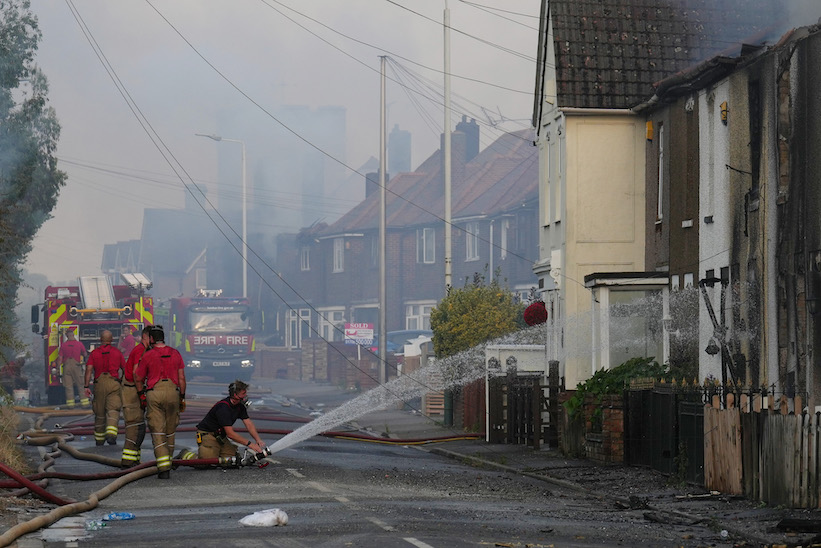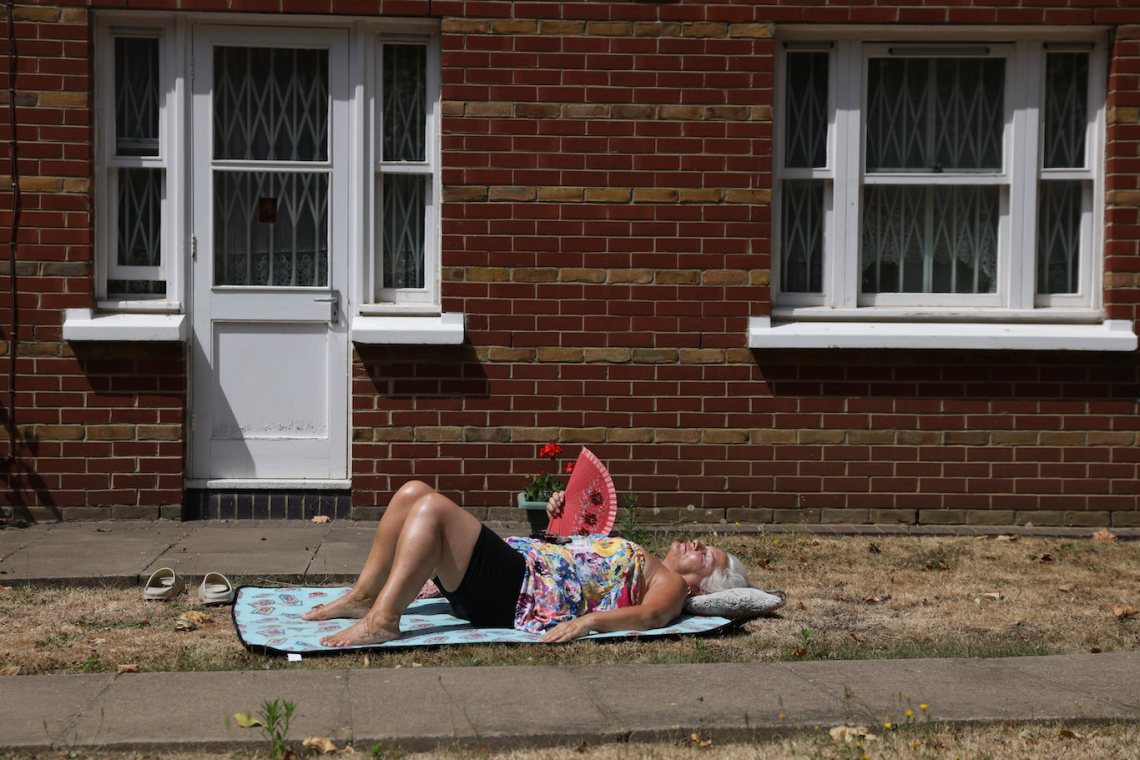Londoners welcome the heat. It’s not that this “grim little rock,” as the English writer Geoff Dyer (now ensconced in California) once called his home country, is entirely starved of sun, but we never know when it will appear or for how long. This is a country whose volatile climes make a mockery of the term “unseasonable,” so nearly as common as “seasonable” weather that it almost can’t be applied meaningfully. It’s never prudent to leave the house without a sweater, and some years winter coats are never stowed away; come July, the question is often not whether this will be a good—a hot—summer, but whether summer will come at all. Can we cobble together enough spells of “t-shirt weather” to justify a season? Warm weather is so erratic that heatwaves—a succession of “scorchers,” as they are appreciatively known—are greeted with a febrile collective excitement.
In much of the rest of Europe people are accustomed to the sun, which shines uninterruptedly for months without fanfare. Denizens of those sun-spoiled regions sensibly treat the heat as the inconvenience and potential hazard it is: something that makes you sweaty, sleepy, thirsty, and, if you’re not careful, sick, and which is to be managed not reveled in—by keeping shutters closed, staying inside during the hottest part of the day, taking siestas, and eating late. In sweltering cities from Madrid to Palermo, those who can evacuate for the month of August and head for bodies of water.
During a London heatwave, by contrast, everyone seems to stop what they’re doing and commit themselves to basking with abandon. Whether in parks, backyards, pub gardens, or one of the capital’s teeming lidos, this means, for most, getting pissed and sunburnt. The reckless euphoria with which periods of crop-withering, grass-parching drought are received in London is such that it’s galling to find yourself abroad during one, since you know you are not simply missing “good” weather but an event, a cultural moment. Like an underdog soccer team with a staunch fanbase, British weather may be among the worst in Europe, but the ecstatic reception earned by its surprise victories is second to none.
The build-up to the heatwave that hit the UK in mid-July, prompting the country’s first “red” extreme heat warning, felt markedly different. The week before, I was in Italy at an English couple’s wedding (destination weddings are themselves a symptom of the UK’s mercurial summers). Peering at our weather apps, our eyes widening at the unprecedented temperatures we’d be returning home to—40 degrees Celsius (104 degrees Fahrenheit)—the mood, goaded by tabloid histrionics (“Hotter than the Sahara,” The Sun blared), was apprehensive, even somber. Twitter flooded with tips on how to stay cool and recognize heatstroke. People took to signing off emails with allusions to the heat (“hope you’re staying cool”), reprising the solicitous etiquette that developed early in the pandemic, quicky becoming mandatory and then stale. I thought about a deadline I was likely to miss, and wondered if it might actually be too hot to concentrate in my small, naturally warm south London flat—and whether, wickedly, I could cite the weather as an excuse.
Since temperatures well in excess of forty degrees have already become quite common in other regions of the world, particularly in poor countries less able to adapt to such extremity, it’s difficult not to regard the British reaction as melodramatic. As Britain portentously braced itself, even fiercer heat ripped through southern Europe: wildfires raged in France, and the World Health Organization reported 1,700 heat-related deaths in Spain and Portugal, where temperatures hit 46.3 degrees (115 Fahrenheit). This episode of exceptional heat spanned the northern hemisphere, also affecting swathes of China and the US, and followed a torrid, lethal spring in India, where temperatures passed 49 degrees (121 Fahrenheit) in Delhi in May.
But forty degrees, in the UK, is a truly alien figure, signaling a wave of stay-inside, hot-in-the-shade heat; heat not just beating down from the sun but hanging, stiflingly, in the air; heat which the breeze would convey rather than disperse. One columnist would describe the wind as feeling like a “hairdryer.” This was not a random blessing from our wantonly capricious meteorological gods but crude proof that the world is now dangerously hot, hotter than it has ever been in human history. Cowering from the blazing midday Italian sun in stone villas, the other wedding guests and I had the unprecedented experience of fretting about how we would handle the heat when we got home, weighing possible sanctuaries—friends who lived on the coast or in the countryside—from the urban oven of our scantily air-conditioned city.
Advertisement
Chaos ensued when the heat arrived. Things ground to a halt, not in a jubilant downing of tools but because much infrastructure went into meltdown, some literally: runways melted, railway tracks optimized to be “stress-free” at a mere 27 degrees buckled, power lines sagged and collapsed, highways closed because of roadside fires. London’s frail Hammersmith Bridge on the River Thames was covered in reflective foil so that it wouldn’t crack and give way.
The little weather emoji on the dashboard of my laptop, in sunny weather usually a serene orange circle, turned into an alarming red triangle containing a thermometer and a fire symbol. Cycling through central London on the second morning of the heatwave I came across fire trucks and ambulances gathered around Oxford Circus station, usually one of the busiest in the city—evacuated, I read later, because smoke was seen issuing from an escalator’s overheating brake pads. A “major incident” was declared in London, where Mayor Sadiq Khan said the fire brigade had had its busiest day since World War II. Grass and heath fires erupted and some spread to homes in places like Wennington, Dagenham, and Upminster along the city’s green—now “tinderbox-dry”—eastern periphery.
The BBC gravely rose to the occasion, dispensing practical advice and beaming live notifications to the nation’s phones as temperature records were shattered across the country. The sense of solidarity in what had been declared a “national emergency” was a grim echo of the festive atmosphere of previous heatwaves. Meanwhile, in the kind of preposterous juxtaposition to which we creatures of the Anthropocene have become habituated, the European parliament had just voted to reclassify natural gas, a fossil fuel, as a “green” energy source, and Senator Joe Manchin sunk Joe Biden’s original climate package, seemingly irremediably.
According to research from the Dondena Centre in Milan, very high temperatures supposedly boost support for climate action in rich, colder countries. But it seems likely that we’ll adapt to the heat much faster than we’ll be motivated to mitigate it. The UK will install energy-guzzling AC units and expensively update its infrastructure, built for historically clement weather. We’ll cognitively acclimate to formerly unheard-of temperatures, which, like inflated prices, are quickly becoming new benchmarks of normality, while “normal” no longer bears a reliable relation to our more temperate past, let alone to anything resembling a humane, survivable future. Meanwhile, as protracted heatwaves become frequent mass death events, especially closer to the equator, the project of “global mitigation,” as the Marxist historian and urban theorist Mike Davis predicted over a decade ago in his essay “Who Will Build the Ark?” will “be tacitly abandoned—as, to some extent, it already has been—in favor of accelerated investment in selective adaptation for Earth’s first-class passengers,” creating “green and gated oases of permanent affluence on an otherwise stricken planet.”
As I write, the heat has broken, and the weather in London is overcast and blustery, a hint of chilly drizzle in the air: reassuringly unseasonable for late July. It’s sad that summer is now potentially scary; that hot spells—so recently a thrill for Vitamin D-deprived Londoners—are now another species of disruptive, dangerous weather, deadlier, like most things in our intolerably unequal world, for some than others; and that exceptional weather no longer seems innocently random, but is freighted with an awful intelligibility, a blatant reminder of the frightening future that those with power, by their inaction, are forging.



